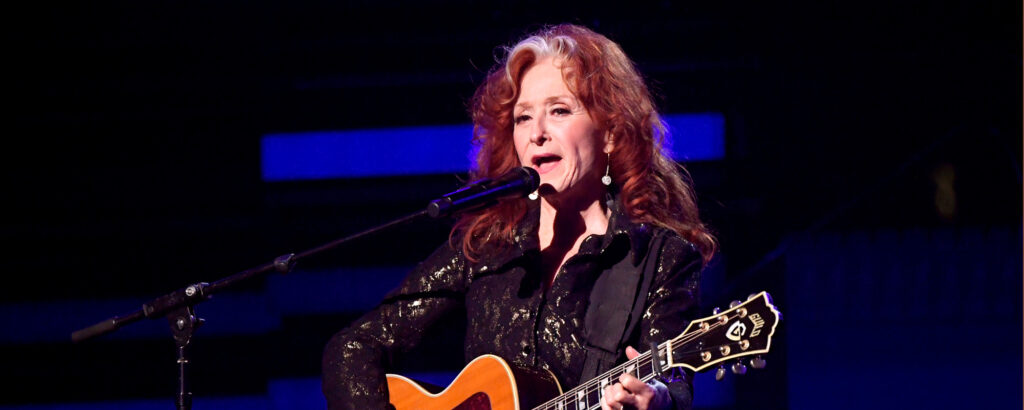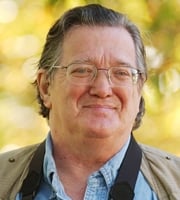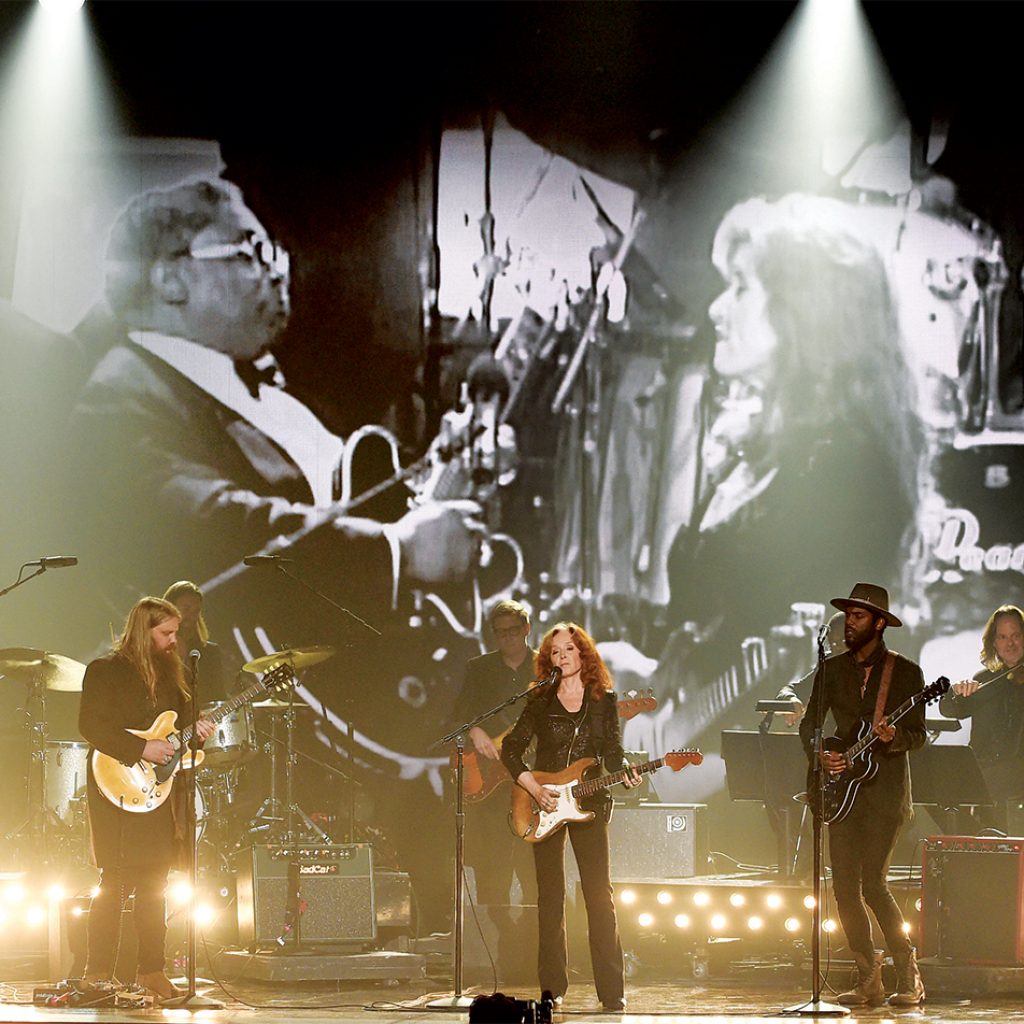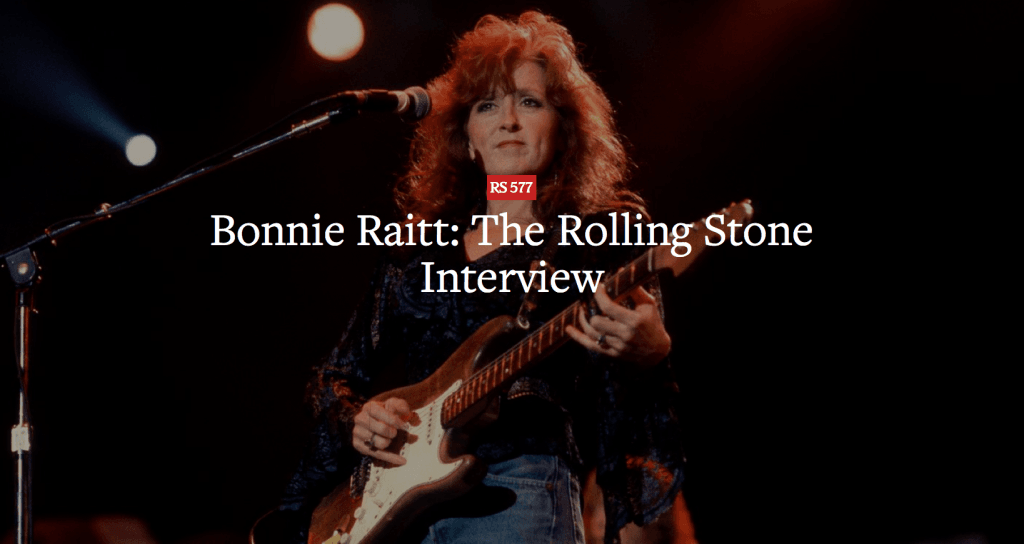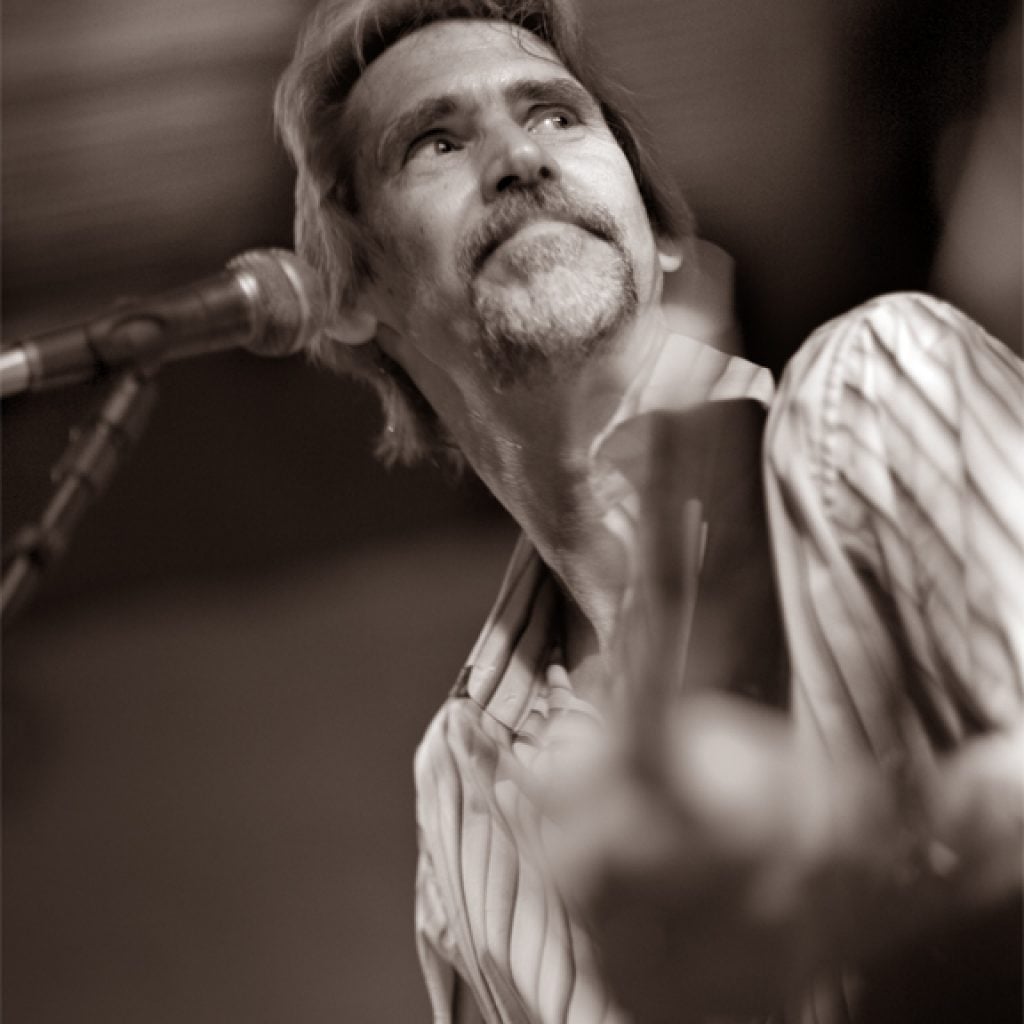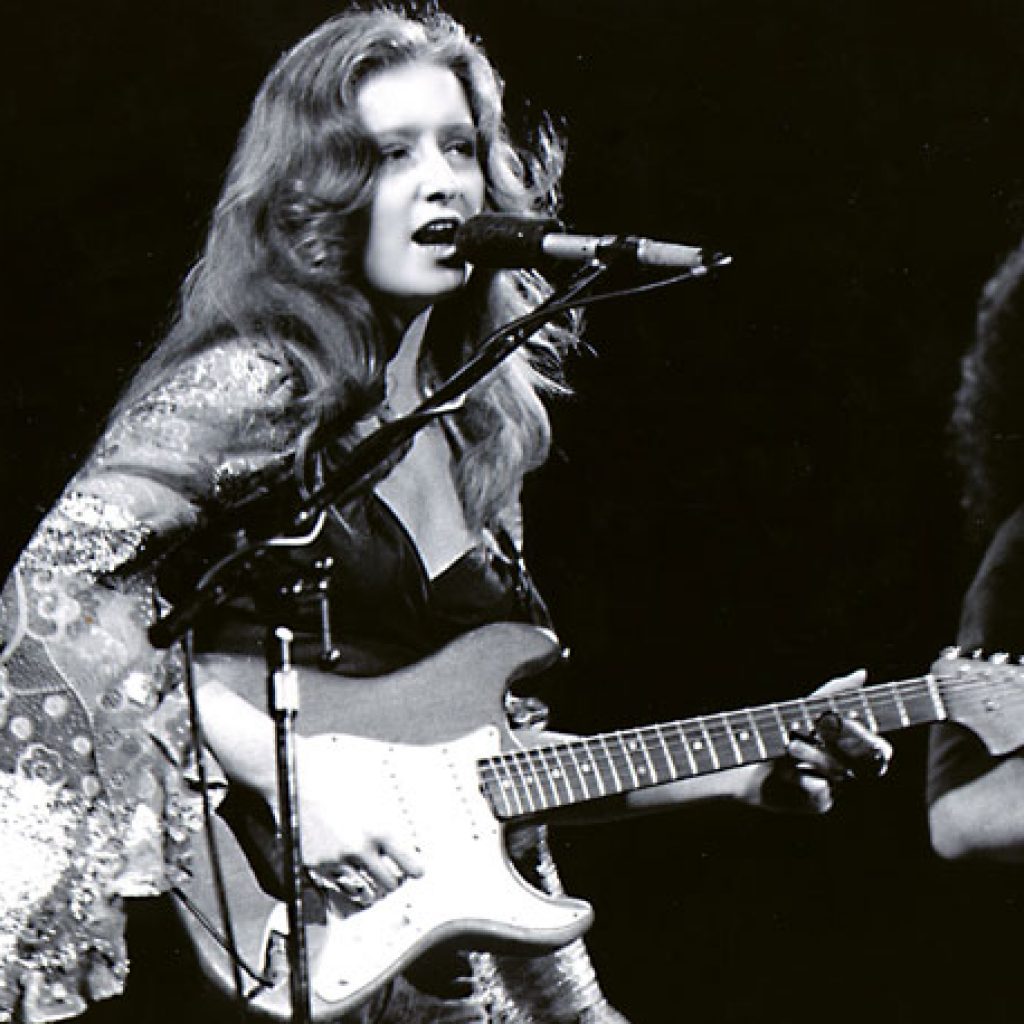
Yes, Bonnie Raitt has won another Grammy, and she talked to Goldmine about the album ‘Just Like That,’ reflecting on love and loss in the 21st century.
My little girl, pink and white as peaches and cream is she My little girl is half again as bright as girls are meant to be Dozens of boys pursue her, many a likely lad Does what he can to woo her from her faithful dad
John Raitt was a legend of Broadway. The passionate tenor had a warmth in his golden voice that was perfect for the theater, perfect for the music that required a singer to occupy a song as the character in the musical play unfolding onstage, like that of carousel barker Billy Bigelow in Carousel as he anticipates becoming a father to “My boy Bill, I’ll see that he’s named after me,” before realizing that his unborn child may turn out to be a daughter instead of a son. The song was called “Soliloquy,” and I’ll bet Raitt thought of his only daughter in real life each of the thousands of times he sang it. Bonnie Raitt would go into the family business, too, taking an equally passionate but decidedly different path.
Young Bonnie didn’t choose the family business simply because her famous father had wowed audiences for decades, but had it not been for John Raitt taking The Pajama Game, Oklahoma! and Carousel on the road each summer, she and her brothers wouldn’t have traveled to summer camp in the early 1960s. That’s where and when she discovered music of conscience in the worlds of folk, blues and rock music, which she’s been making now for half a century, with more than 10 Grammy awards (“Just Like That” being the latest for Song of the Year), more than 20 albums and more than a handful of songs you know by heart. Throughout it all, the road has been her middle name, just as it was for her father doing summer stock. She made Billy Bigelow proud.
I had the great pleasure of speaking with Bonnie about Just Like That …, her excellent newest release, of which she is as excited as she must’ve been at the time of her first album in 1971. She has every right to be, as Just Like That … slides right into her canon as a perfect fit in the soulful singing and slide guitar playing musical life of Bonnie Raitt. The album finds Bonnie reflecting on the pandemic and other topical matters while ultimately uplifting us just as her blues heroes did.
Bonnie had much to tell Goldmine of her journey, and she did so with genuine kindness and enthusiasm. We talked about the latest record, her first record, her sobriety, her musical friends and the father who first gave her the love of song.
GOLDMINE: Recording artist Sara Hickman told me just yesterday that she once heard you on a panel being asked if you had any regrets. She said that your answer was that you had none, because if not for your mistakes, you wouldn’t have been sitting there at that moment. Do you still feel this way?
BONNIE RAITT: Oh, wow! There you go. I think what I mean is whatever I went through got me where I am today, including bad romantic decisions, all that stuff. We wouldn’t be who we are sitting here right now so lucky to be alive.
GM: The record Just Like That … is outstanding, Bonnie! The record feels like you’re going through a lot of reflection. The whole thing is a reflective piece throughout, in a great way. Do you see it that way? Was there a life-and-death theme?
BR: I get asked that often, and I have to be honest and say it’s just a stringing together of my 10 favorite songs. I don’t have any concept or unifying force. I mean, sometimes there’s something I went through. I wrote a song about my dad called “Circle Dance,” and I wrote a song on my last record called “The Ones We Couldn’t Be.” That’s just one song, but it means a lot to me. The ones that I write are usually related to something I’ve been going through personally, although on this record I really wanted to stretch and do something that wasn’t mining my personal life. That’s why those two story songs ended up there, but some of the other songs, I really had for a long time. It was just a question of when it was their turn to put them on a record where they sound good together.
That Al Anderson (of NRBQ) song, “Something’s Got a Hold of My Heart,” I’ve had that song for 30 years, and he never believed I was ever going to record it, and I still haven’t picked up the phone and told him that I actually made the record. My favorite part of the cycle of five years every record is the moment when I know I can call the songwriter who has no idea that I cut their song. And that is such a great phone call!
GM: Both of those songs fit your canon. You can’t tell that Al’s song was 30 years in the queue, because “Something’s Got a Hold of My Heart” could slide into any Bonnie record.
BR: Well, thank you. I could not shake it. It hadn’t fit or other songs bumped it out, so I’m so glad you like it. It reminds me of “Can We Still Be Friends,” that simple piano part, you know that Todd Rundgren song. There’s a certain kind of a Bill Withers, very primitive simple piano playing style. I’ll bet Al just sort of moved his hands around while he was singing that song. It’s so innocent and so cool. It’s got a great groove to it. I’m still like a mother that just had kids. I’m so excited about my album. I can’t wait to play these songs live!
GM: “Livin’ for the Ones” by you and your guitarist George Marinelli is all about loss, but it has such hope in it. Tell me what that one means to you.
BR: I wanted one song about what we’ve just been through in the last few years. I wanted specifically to write a song about how the hell any of us could make it through, and I thought about it, and I used a title from something that I adopted when my brother passed away from brain cancer, followed a month later by my friend (singer-songwriter) Stephen Bruton, and I just was devastated. I just said, “Man, I don’t know how I can make it through,” but then I realized everything I wrote about on that song, for all the chances they didn’t get. My brother went blind at the end. He couldn’t open his eyes and just look out the window.
Whenever I’m gonna bitch and moan, I think about people that lost their life early. And so many of my friends I lost this last couple of years to cancer and suicide and accidents, but Toots Hibbert and I were gonna cut this song together. I’ve been wanting to do “Love So Strong” since Taj (Mahal), and I did it on our BonTaj Roulet tour in 2009. I was so surprised; he was in such great health after coming back from having had his head injury. Somebody threw a bottle up from the audience and cracked it into his skull. He had to retire for five years so he could be better enough to come back on the road. He was just back on the road, and he was cut down by COVID. And then John Prine was one of the most tragic losses of my life, so I really was holding those guys in my heart.
Fourteen people I dedicated the record to that I’ve lost the last couple of years. I really feel strongly about “Livin’ for the Ones.” That’s the third song I worked on with my longtime guitar player George Marinelli. He sent me these rocking tracks. That’s how to get me to write, is if the song is so badass, the track is so great and I can’t wait to play it, then I have to come up with some lyrics for it. So that was the inspiration for what I think is the most reflective song on the record, in terms of reflecting what we’ve been through lately.
“I said, ‘Oh man, if I quit partying, I’ll just play real wussy and write stupid songs about how everything’s so much better now,’ and that’s not the case. You can be sober and be a badass, so there you go!
— Bonnie Raitt
GM: In one respect, it reminds me of Elton John’s “Sad Songs (Say So Much),” as it has more serious lyrics but a track that jumps. I wondered if the lyrics came first Bernie Taupin-style, but I guess they didn’t!
BR: Yeah, I knew that I was gonna write a song about what we went through, and I didn’t know what music it was gonna have, but when he sent the track, I went, “That’s it!” The catharsis of playing a rocker with words that you mean that much gets all the juices flowing to the point where sometimes I have to recover after I finish the song because it taps such a deep vein in me. What better song to come out after a pandemic? The next time you wanna bitch and moan, think about everybody that didn’t even make it.
GM: I love the joyous attitude of that song. I just turned 60 and have realized how lucky I am to be here.
BR: It’s been a real reckoning: this COVID pandemic, the election, Black Lives Matter, the climate crisis, all of these things coming, pile-driving on while you don’t even have the outlet of seeing your friends and playing music, in our case, and you just have to re-prioritize. You know what? I’m just damn lucky I can go sit on the porch and have a cup of coffee and not have a bomb fall on my head or that my lungs don’t work or that I’m sick and I’m on an oxygen tank. I am not gonna complain again, you know what I mean? This pandemic has kicked my ass and reprioritized everything that’s important.
GM: Amen to that, but I still manage to complain about things!
BR: I know, me too! (laughs) The other song I’m really proud of is “Waitin’ for You to Blow.” I wanted to stretch musically and do something. I’ve always loved Les McCann and Eddie Harris and I love funk music, and I wanted to mix The Crusaders and Stuff. Some of my favorite bands do that kind of jazz/funk combo. I created that whole drum track and keyboard parts with the kind of jazzy chords that you normally wouldn’t expect in a funk tune and all the little horn parts that we played on guitar and organ. I wanted to stretch and do something that I’ve never done before and put a shuffle in the bridge. I’m really proud of the band for going with me on that. And then to write a song about the devil on your shoulder that’s trying to urge you to slip up.
GM: I know that one is about your sobriety. How many years sober?
BR: Thirty-five for alcohol and drugs, but as anybody that’s in recovery knows, the work comes from all the character defects of slipping into behaviors that are just not the way you’re supposed to be operating. You get away with a little bit, give yourself a little leeway, nobody’s perfect, but all those things itemized in those verses are so real to me, including you get love close enough, what if they find out there’s nobody in there, that nobody’s worth loving in there? That’s as serious a topic I ever sang about, but because it’s in a funk tune, you don’t notice it.
GM: On the subject of “Waitin’ for You to Blow,” I read that you’ve credited Stevie Ray Vaughan as being instrumental in your sobriety. I want to ask about Stevie’s influence both ways, with regard to recovery and his blues guitar impact on you.
BR: There was a bunch of people who got sober before me. Mike Finnigan was in my band, and we just lost him. He and his wife were crucial friends of mine. Paul Barrere from Little Feat, who passed away from cancer (in 2019), John Hiatt, Mike Finnigan, Barrere, and Stevie Ray, who I’d just toured with earlier. He came out of rehab, and the first time he played guitar, we were playing at Center Stage in Atlanta, and his mom and him came to the show, and I said, “Do you want to sit in?” He said, “Well, I don’t know.” He was just so newly sober. Not that we played completely hammered all the time. He got up onstage, and that’s what was inspirational to me. The last excuse I had for not getting sober was watching how he played that night and what changes had come over him. I felt the same way about the other people I just mentioned. They just were funnier, happier, healthier and didn’t lose any of their edge. If anything, they were playing better than ever. That was my last excuse. I said, “Oh man, if I quit partying, I’ll just play real wussy and write stupid songs about how everything’s so much better now,” and that’s not the case. You can be sober and be a badass, so there you go!
GM: I want to ask about “Just Like That” and “Down the Hall.” These are both written by you, they’re both story songs, they’re both true, and they both just leveled me. They’re both about appreciating life in the end.
BR: Oh, thank you! I mean, I’m sorry to upset you! (laughs) They upset me, too. I had really mined my own personal life for a lot of the songs I wrote for the last bunch of albums. I covered a lot of topics, “Tangled and Dark,” “Spit of Love,” “The Ones We Couldn’t Be,” “One Part Be My Lover” — there’s a lot of songs. I just didn’t want to go over territory I had already covered. I was so inspired by Jackson Browne’s early records and Bob Dylan’s first two albums, and then my friend John Prine, the way he crawled into that woman’s life and heart in “Angel from Montgomery” and “Donald and Lydia” and “Hello in There,” there’s nobody better.
I wrote the lyrics for both those songs in 2019. I didn’t put them to music until right before I recorded in June (2021). I just wanted the songs to write themselves. I just sat there with my guitar. “Just Like That” was completely inspired by John Prine. I tuned to open tuning for “Down the Hall.” Paul Brady, I love that Celtic music. You know, Bob Dylan credits Paul Brady’s “Arthur McBride” in a lot of his work, where he gets his ideas on “Masters of War.” Four or five of his songs on his early records are inspired by the Irish Celtic tradition. Open-tuning songs just kind of write themselves that way. They have that melody built in.

GM: I interviewed Spider John Koerner just before the pandemic. You recorded one of his songs on your first album. What do you have to say about Spider John or Koerner, Ray & Glover and their impact on your work?
BR: You mean that song “I Ain’t Blue,” right? I love that song. It’s very uncharacteristic of John’s music. I was always a Koerner, Ray & Glover fan and John’s solo albums as well. We ran into each other in (Greenwich) Village (New York City), and I got to meet one of my heroes. And then he moved to Cambridge (Massachusetts), where I was living and had a regular gig at Jack’s Bar on Monday nights where all the musicians in town, folkies and stuff, would come and hang out and listen to John play. He made a record on Elektra called Running, Jumping, Standing Still with Willie Murphy, who I had never heard of. Willie had a band called Willie and the Bees. Minneapolis had this incredible scene like New Orleans where black and white musicians were all intermingled. There wasn’t any segregated soul music scene or jazz scene or rock and roll scene or country scene. It was just a great music scene with everybody playing with each other. That’s why Prince knew all my early records. I went, “How did you know that?” He went, “We’re from Minneapolis!” My friend Peter Bell from Cambridge said, “You should make your first album with Willie and the Bees, because they’ll play all your music perfectly.” Then I had the idea of bringing Junior Wells in and A.C. Reed from Chicago who I knew, and we went to a remedial reading summer camp and Snaker Dave Ray from Koerner, Ray & Glover did the recording. So the first album, I loved doing “I Ain’t Blue.” It fit my voice so well, and I have been a John Koerner fan (since) I was 15 or 16 when I heard Koerner, Ray & Glover. Like Dave Van Ronk and John Hammond, I just couldn’t believe white guys were authentic singing the blues, and they were. I felt like it was OK for me to do what I did because they could do what they did.
GM: That leads to the other person I wanted to talk about: I want to know how you were led to the blues after the influence of that other person, your father. My mother turned me on to his music, and I had a hand in turning her onto yours.
BR: Oh, I’m so glad when I find someone who knew my dad! You sound like you’re 25, but if you’re 60, she probably hipped you to some of those Broadway shows. I’m so grateful to talk about him because he was such an influence on me. After he passed away, we put up a website, and there’s some really great videos of him performing on The Ed Sullivan Show, from Annie Get Your Gun, I recorded three tracks from his Grammy-nominated album in ’95. I helped out so many R&B legends when I got famous: I took Ruth Brown and Charles Brown on tour, I worked in the Rhythm and Blues Foundation for 20 years, and in the middle of the ’90s, I went, “Hell, I got like a legend right in my family! I’m gonna make a record with him!” There’s a lot of stuff on johnraitt.com that are just treasures, the story of his career, a list of his records.
GM: You took a different musical path from that of your father, but it’s the same line of work. How did you find your way over to the blues?
BR: I was at summer camp. My dad was on tour. Every summer, he spent three months in summer stock taking his hit shows in regional theaters, a lot of times outdoors in pants with no air conditioning. And that was the circuit of summer stock theater. He’d alternate in Carousel, Oklahoma! and Pajama Game from 1958 until ’66. Our family friends had a summer camp at the Adirondacks up by Saranac Lake, which is like a half hour from Lake Placid (in New York). So every summer from L.A,. we would all fly across and go to this camp while my folks were on tour. The camp counselors were all swept up in the folk revival: Kingston Trio, Joan Baez, Odetta, Pete Seeger. In ’59, ’60, everybody was getting a guitar. Everybody was learning folk songs, and I was enamored of my counselors that would sing these beautiful songs around the campfire. Then I discovered Joan Baez, who like us was Quaker, and she lived in California, and she was Scottish like we were. I begged for a guitar when I was eight, and I got it for Christmas. My grandpa taught me how to play a couple of chords, and I was off and running.
GM: Your avenue into music was so different from your father’s.
BR: My folks would trot me out when I was nine and 10 and play protest songs in the living room. They thought it was cute. I led the campfire songs. I was a really serious folkie and wanted to go change the world. Because we were Quaker, we were very involved in civil rights, social justice and the peace movement, so all my heroes were like eight years older than me, and I was racing to get old enough to go to Greenwich Village. The best I could do is I made it to Cambridge while the Vietnam War rallies were going on, the feminist movement, the pill came in. I chose to go to school in Cambridge because it was just a hotbed of folk music and political activism as well as just being a great school. I just got in on the tail end of the folk music scene with no intention of doing it for a living. It kind of just fell in my lap. My hobby turned out to be a career because there was not that many women who could play good blues guitar.






 Visitors Today : 24
Visitors Today : 24 Who's Online : 0
Who's Online : 0



